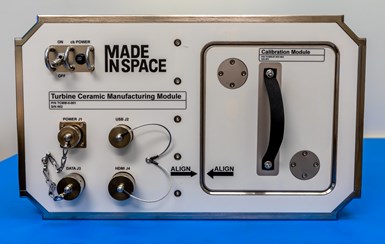Made In Space Sends Ceramic Manufacturing Module to International Space Station
Commercial in-space manufacturing device is designed to demonstrate proof-of-principle, single-piece ceramic turbine blisk manufacturing in microgravity for terrestrial use.

Ceramic manufacturing module
Made In Space Inc. (MIS) launched the first ceramic manufacturing module payload to the International Space Station (ISS) on Northrop Grumman’s 14th commercial resupply mission (NG-14). The Turbine Ceramic Manufacturing module (CMM) is a commercial in-space manufacturing device designed to demonstrate proof-of-principle, single-piece ceramic turbine blisk manufacturing in microgravity for terrestrial use. The NG-14 launched Oct. 2 from NASA’s Wallops Flight Facility on Wallops Island, Virginia.
According to the company, manufacturing turbine components in microgravity could produce parts with better performance, including higher strength and lower residual stress, due to a reduction in defects caused by gravity, such as sedimentation and composition gradients. This technology demonstrates the space station’s potential use for unique manufacturing capabilities which could increase the station’s commercial utilization.
The CMM is a new 3D printing technology on the ISS and will be the first stereolithography (SLA) printer to operate in orbit. This 3D printing method employs UV-curable resin and a UV laser to form 3D-printed objects. SLA printing is well-suited for manufacturing high-accuracy parts with complex geometries. MIS pioneered manufacturing capabilities in space with its first- and second-generation 3D printers, with on-orbit operations dating back to 2014.
MIS is a subsidiary of Redwire, a provider of mission-critical space solutions and high-reliability components. “This mission is an exciting opportunity that further demonstrates the value of the ISS as a platform for commercial innovation and utilization,” says Michael Snyder, chief engineer of Made In Space and chief technology officer of Redwire. “Through our partnership with NASA, we are identifying and developing advanced manufacturing processes on orbit that could yield sustainable demand from terrestrial markets. CMM is the first of several missions that could signal a new market for space-enabled products.”
The CMM was developed in partnership with NASA’s ISS Research Integration Office at the Johnson Space Center, HRL Laboratories of Malibu, California, and Sierra Turbines of San Jose, California.
Related Content
-
3D Printed Lattice for Mars Sample Return Crash Landing: The Cool Parts Show Bonus
NASA Jet Propulsion Laboratory employs laser powder bed fusion additive manufacturing plus chemical etching to create strong, lightweight lattice structures optimized to protect rock samples from Mars during their violent arrival on earth.
-
Additive Manufacturing at NASA (Part 2): AM Radio #52
In this follow-up podcast episode on additive manufacturing at NASA, Dr. Tim Simpson joins us to discuss how the organization thinks about AM overall, and its role in advancing additive alongside and in service of commercial industry.
-
8 Transformations 3D Printing Is Making Possible
Additive manufacturing changes every space it touches; progress can be tracked by looking for moments of transformation. Here are 8 places where 3D printing is enabling transformative change.













